The Hybrid Grafts Market is estimated to be valued at USD 602.3 million in 2025 and is projected to reach USD 999.9 million by 2035, registering a compound annual growth rate (CAGR) of 5.2% over the forecast period.
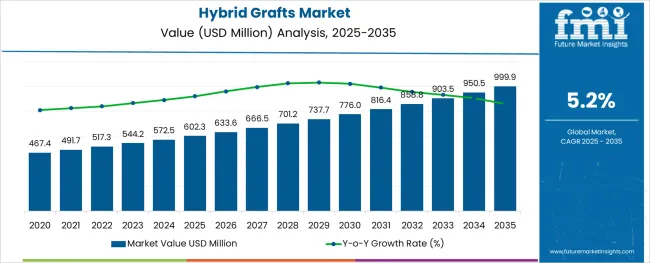
The hybrid grafts market is expanding steadily, driven by advancements in vascular surgery and increasing prevalence of cardiovascular diseases. The rising number of complex aortic procedures has heightened demand for hybrid grafts that combine the benefits of open surgery and endovascular repair. Improved surgical outcomes and reduced patient recovery times have encouraged adoption across healthcare settings.
Hospitals are investing in advanced surgical devices to enhance procedural efficiency and patient safety. The integration of hybrid grafts into treatment protocols aligns with the need to manage thoracic aortic conditions more effectively. Growth is also supported by an aging population and increased screening for vascular diseases.
Future market expansion is expected as clinical innovation continues and surgical teams seek versatile graft options. Segment growth is led by thoracic aortic graft products and hospitals as the primary end user due to their role in advanced surgical care.
The market is segmented by Product and End User and region. By Product, the market is divided into Thoracic Aortic Graft and Peripheral Vascular Graft. In terms of End User, the market is classified into Hospitals and Ambulatory Surgical Centers. Regionally, the market is classified into North America, Latin America, Western Europe, Eastern Europe, Balkan & Baltic Countries, Russia & Belarus, Central Asia, East Asia, South Asia & Pacific, and the Middle East & Africa.
Insights into the Product Segment: Thoracic Aortic Graft
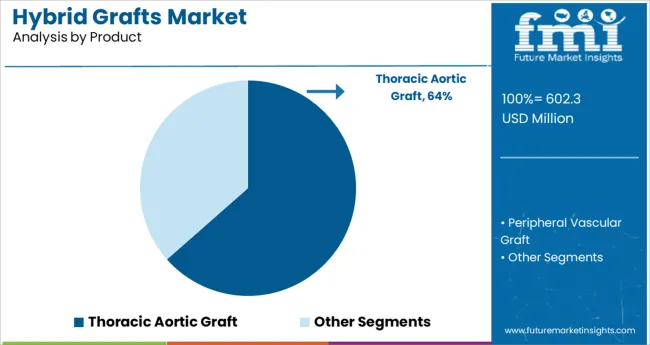
The thoracic aortic graft segment is expected to hold 63.5% of the hybrid grafts market revenue in 2025. This segment’s growth is attributed to the critical role thoracic aortic grafts play in treating complex aneurysms and dissections of the thoracic aorta. These grafts are designed to accommodate anatomical challenges and provide durable repair options.
Surgeons favor thoracic grafts for their adaptability to both open and endovascular techniques, improving patient outcomes and reducing procedural risks. The segment benefits from technological advances that enhance graft flexibility and compatibility with imaging guidance.
As the incidence of thoracic aortic diseases rises with an aging population, demand for these grafts continues to grow.
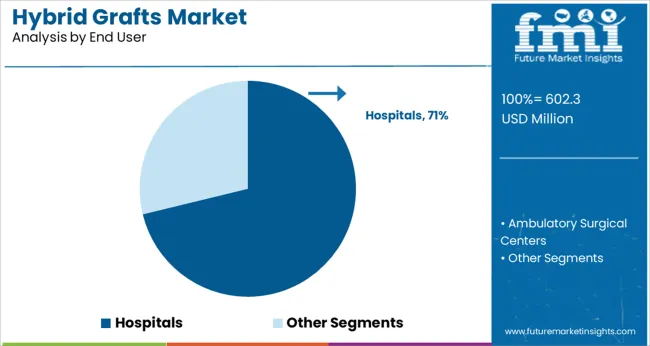
Hospitals are projected to account for 71.2% of the hybrid grafts market revenue in 2025. Growth in this segment is driven by the concentration of advanced cardiovascular surgical procedures within hospital settings. Hospitals provide the necessary infrastructure, skilled surgical teams, and post-operative care required for hybrid graft implantation.
Increasing hospital investments in cardiovascular centers of excellence and the expansion of vascular surgery departments have further strengthened this segment. Additionally, hospitals’ focus on improving patient outcomes and minimizing hospital stays aligns with the benefits offered by hybrid graft technologies.
With ongoing advancements in surgical methods and expanding patient volumes, hospitals are expected to remain the dominant end users of hybrid grafts.
The global hybrid grafts market exhibited a CAGR of approximately 16.6% and reached a valuation of USD 572.5 Million in the global vascular grafts market in 2024.
Demand for hybrid grafts will continue to grow with increasing number of cardiac and vascular surgeries across the globe. With the emergence of technologically advanced methods and instruments, need for minimally invasive procedures is likely to surge at a rapid pace.
Minimally invasive procedures can reduce the physical and economic burden placed on patients by enabling a shorter stay in intensive care units or hospitals. The recovery rate is also faster than that of traditional surgical procedures. Patients who are unable to undergo open surgeries due to complications can easily opt for hybrid graft as it is minimally invasive and less painful.
Prevalence of aortic aneurysms (AAs) has increased in the last two decades owing to growing aging population, increasing number of smokers, implementation of screening programs, and availability of improved diagnostic methods. According to the CDC, in 2020, about 9,904 deaths in the USA occurred due to aortic aneurysms or aortic dissections.
Moreover, peripheral arterial disease (PAD) affects nearly 12%-14% of the general population. Its incidence rises with age, with up to 20% of individuals above the age of 75 suffering from the disease. Some of the major risk factors for PAD include smoking, hyperlipidemia, hypertension, diabetes, and metabolic syndrome.
Males and the elderly are more likely to develop PAD. High level of cholesterol is another crucial factor that may lead to PAD among the geriatric population.
Thus, increasing prevalence of PAD and AAs across the globe is projected to help the global hybrid grafts market to grow at a CAGR of 5.20% during the forecast period from 2025 to 2035.
The global hybrid grafts market is set to create new growth opportunities owing to ongoing development of novel thoracic aortic grafts. Increasing burden of chronic diseases is also expected to drive the market in the upcoming decade.
Rising number of health issues such as high cholesterol and blood pressure among the aging population is set to result in aortic aneurysms. Development of aortic aneurysms is projected to make them more vulnerable to contracting diseases, thereby pushing demand for hybrid grafts.
Cases of sudden injuries are also very common among the aging population. Surging prevalence of cancer and cardiovascular diseases is another vital factor that would contribute to the growth.
As per the WHO, about 17.9 million people die every year because of cardiovascular diseases worldwide and nearly 85% of all deaths associated with cardiovascular diseases are due to strokes and heart attacks. Increasing adoption of minimally invasive procedures on the back of enhanced recovery rates and low hospital stays is thus estimated to propel the global hybrid grafts market.
Graft rejection is considered to be one of the major drawbacks in the global hybrid grafts market. Prevalence of graft rejection is projected to grow at a fast pace as medication management is unable to prevent the same.
High cost of endovascular aneurysm repair treatments is another concern in the global market. Cost of treatment is likely to be unaffordable for a huge percentage of the middle- and lower-middle-class community. Spurred by the aforementioned limitations, demand for hybrid grafts may decline in the forthcoming years.
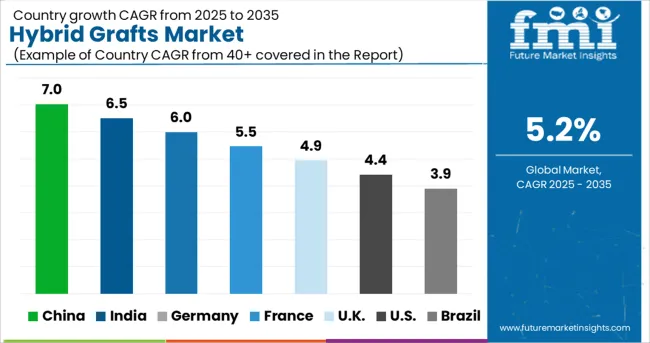
Key Players Are Developing Thoracic Aortic Grafts in the USA
The USA held approximately 38.2% of the global hybrid grafts market share in 2024. Presence of favourable reimbursement policies and increasing incidence of aortic aneurysm are projected to drive the market in the country.
Further, higher adoption of smoking habits and surging dependence on minimally invasive procedures are contributing to the growth in the United States. Companies in the USA are also focusing on the development of thoracic aortic grafts to meet the ever-increasing demand from patients, which would aid growth.
Rising Prevalence of Cardiac and Vascular Diseases to Drive Germany
Germany held a share of about 3.5% in 2024 and is projected to dominate the global hybrid grafts market in the assessment period. Expansion of the healthcare sector, increasing male geriatric population, advancements in minimally invasive procedures, and rising patient pool suffering from cardiac and vascular diseases are anticipated to drive growth.
As per a 2020 study conducted by the German Federal Statistical Office, incidence of thoracic aortic aneurysm repair has grown in Germany. Aneurysms were found in around 48,098 individuals and the age accounted was above 69, with 65.2 percent of the population being male.
Hypertension (74.9%), coronary heart disease (26.2%),peripheral artery disease (particularly abdominal aortic aneurysm, (42.6%), and other heart illnesses (41.6%) were the most common comorbidities that were found in the country.
Increasing number of endovascular repairing procedures that are conducted to combat the prevalence of aneurysm is another significant factor that would create high demand for hybrid grafts in Germany.
Hybrid Grafts to Be Used for Endovascular Aneurysm Repair Procedures
China hybrid grafts market is estimated to generate nearly 3.8% of share during the forecast period (2025 to 2035). Ongoing development of the country’s healthcare industry with the addition of innovative products and high patient holding capacity is expected to bode well for the market.
Easy availability of premium quality, yet cost-effective medical instruments in China is also likely to push the market. Increasing number of endovascular aneurysm repair (EVAR) procedures in the country is another vital factor that would aid sales of hybrid grafts.
Moreover, leading Chinese medical device companies are aiming to enter untapped areas for increasing their sales, which would further accelerate growth in the hybrid grafts market in China during the forecast period.
Thoracic Aortic Grafts to Gain Impetus with Prevalence of Chronic Diseases
Based on product, the thoracic aortic grafts segment is expected to exhibit high growth at a CAGR of 5.6% in the forecast period and hold a share of about 78.2% in the global hybrid grafts market in 2035. Thoracic aortic grafts are gaining traction due to rising prevalence of various chronic diseases with the adoption of unhealthy lifestyles.
Recent developments and modifications in the field of thoracic aortic grafts on the back of changing raw materials and processing techniques are further expected to boost growth of the segment in the global hybrid grafts market.
Hospitals to Conduct More Surgical Procedures in Future
Based on end user, hospitals held the highest hybrid grafts market share of 59.2% in 2024. Growing prevalence of cardiac and vascular diseases, as well as increasing number of surgical procedures would drive the segment, thereby propelling sales of hybrid grafts in the evaluation period.
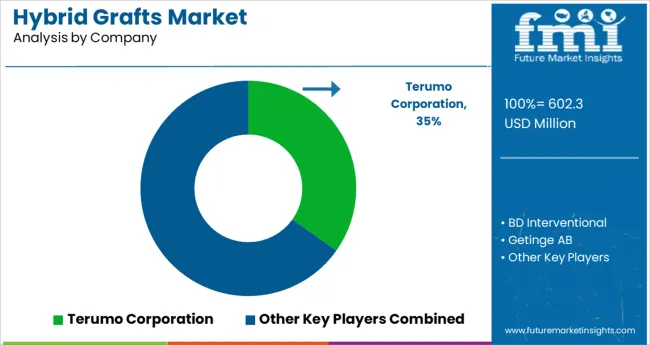
The global hybrid grafts market is moderately fragmented with the presence of various key players. To meet the high consumer demand and expand their customer base, these companies are developing new materials and manufacturing techniques.
Some of the recent industry developments by key players in the hybrid grafts market are given below:
| Attribute | Details |
|---|---|
| Estimated Market Size (2025) | USD 602.3 million |
| Projected Market Valuation (2035) | USD 999.9 million |
| Value to based CAGR (2025 to 2035) | 5.2% |
| Forecast Period | 2025 to 2035 |
| Historical Data Available for | 2020 to 2024 |
| Market Analysis | million for Value |
| Key Regions Covered | North America; Latin America; Europe; South Asia; East Asia; Oceania; and Middle East & Africa |
| Key Countries Covered | USA, Canada, Brazil, Mexico, Argentina, UK, Germany, Italy, Russia, Spain, France, BENELUX, Nordic Countries, India, Thailand, Indonesia, Malaysia, Japan, China, South Korea, Australia, New Zealand, Turkey, Egypt, GCC, and South Africa |
| Key Market Segments Covered | Product, End User, and Region |
| Key Companies Profiled | Terumo Corporation; BD Interventional; Getinge AB; Merit Medical Systems, Inc.; JOTEC GmbH |
| Report Coverage | Market forecast, company share analysis, competition intelligence, DROT analysis, market dynamics and challenges, and strategic growth initiatives |
The global hybrid grafts market is estimated to be valued at USD 602.3 million in 2025.
It is projected to reach USD 999.9 million by 2035.
The market is expected to grow at a 5.2% CAGR between 2025 and 2035.
The key product types are thoracic aortic graft and peripheral vascular graft.
hospitals segment is expected to dominate with a 71.2% industry share in 2025.






Full Research Suite comprises of:
Market outlook & trends analysis
Interviews & case studies
Strategic recommendations
Vendor profiles & capabilities analysis
5-year forecasts
8 regions and 60+ country-level data splits
Market segment data splits
12 months of continuous data updates
DELIVERED AS:
PDF EXCEL ONLINE
Hybrid Reactive Power and Harmonic Compensation Device Market Size and Share Forecast Outlook 2025 to 2035
Hybrid Vision Sensor Chips Market Size and Share Forecast Outlook 2025 to 2035
Hybrid Printing Market Forecast Outlook 2025 to 2035
Hybrid Boat Market Size and Share Forecast Outlook 2025 to 2035
Hybrid Metal-Paper Seamers Market Size and Share Forecast Outlook 2025 to 2035
Hybrid Sealing-Cut Machines Market Analysis - Size and Share Forecast Outlook 2025 to 2035
Hybrid Powertrain Market Size and Share Forecast Outlook 2025 to 2035
Hybrid Additive Manufacturing Machines Market Size and Share Forecast Outlook 2025 to 2035
Hybrid Integration Platform Market Size and Share Forecast Outlook 2025 to 2035
Hybrid Marine Gensets Market Size and Share Forecast Outlook 2025 to 2035
Hybrid Meat Products Market Size and Share Forecast Outlook 2025 to 2035
Hybrid Generator Sets Market Size and Share Forecast Outlook 2025 to 2035
Hybrid Switchgear Market Size and Share Forecast Outlook 2025 to 2035
Hybrid Rice Seeds Market Size and Share Forecast Outlook 2025 to 2035
Hybrid Memory Cube Market Size and Share Forecast Outlook 2025 to 2035
Hybrid Aircraft Market Size and Share Forecast Outlook 2025 to 2035
Hybrid Solar Wind Market Size and Share Forecast Outlook 2025 to 2035
Hybrid Cutters Market Analysis Size and Share Forecast Outlook 2025 to 2035
Hybrid Fabrics Market Size and Share Forecast Outlook 2025 to 2035
Hybrid Train Market Analysis - Size, Share, and Forecast Outlook 2025 to 2035

Thank you!
You will receive an email from our Business Development Manager. Please be sure to check your SPAM/JUNK folder too.
Chat With
MaRIA